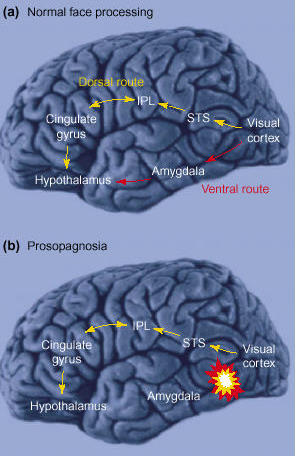Prosopagnosia
From Psy3242
Prosopagnosia
Contents |
Definition
Prosapagnosia is defined as the inability to perceive faces, or face blindness. This has nothing to do with actual visual blindness, as the person is usually able to view everything else normally. It is a perceptual problem that prohibits people from being able to put the image of the face together as a whole. This rare disorder varies in intensity. One person with the disorder may not be able to recognize whether two pictures are of the same face or not, while another patient may affect recognition of one's own family members. In a most severe example, a person may no longer be able to recognize himself in a photograph or the mirror. The picture below gives the impression of what a person with prosopagnosia might see when looking at another person's face.
Prosopagnosia and the Brain
Through the use of many studies on the brain, including PET scans, it seems that prosopagnosia relates to damage to a particular part of the brain. There is an area on the right side of the brain that specializes in perception of people. These area, the ventral regions of the occipital and temporal lobes, have been found to be involved in perception of faces. It is suggested that posterior regions help to put together the individual characteristics of the faces, while the area in front of it aids in identification and memory of bibliographic information of the person to whom the face belongs.
Below the route of facial perception is described through the path of various parts of the brain.
Clearly one of the routes, the dorsal route is intact, but in people with prosopagnosia, the ventral route is disturbed.


